Do you want to know what exercises you should avoid postpartum?
You are in the right place!
After reading this post you will learn:
- how soon after birth you should exercise,
- which postnatal exercises you should avoid, and
- which exercises are best to perform after having a baby.
So if you are ready to start exercising safely, let’s dive right in!
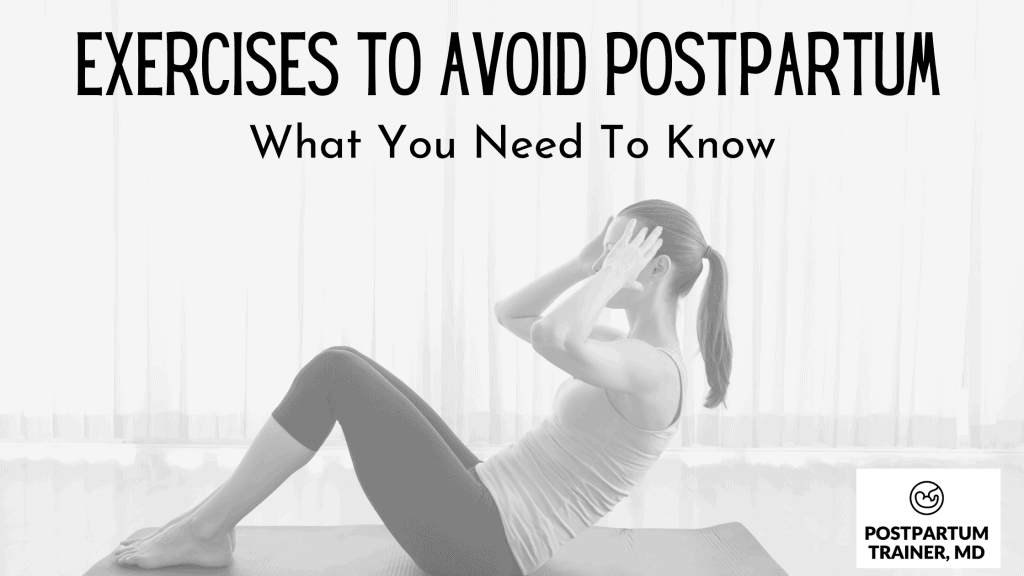
What exercises Should You not do after pregnancy?
In the early postpartum, you should avoid any exercise that places high amounts of tension on your abdomen.
This includes exercises like sit-ups, crunches, and planks.
The reason is that your abdominal muscles are weak and stretched out, and they need time to heal.
The hormone relaxin is also still circulating in your body which increases the laxity of your joints further weakening them.
If you had a cesarean section, many layers of tissue were cut to access your uterus.
Again, these tissue layers need time to heal to avoid any post-operative complication.
Now let’s go over the exercises you should avoid in more detail.
Here is a list of exercises you should avoid postpartum:
Sit-ups
Sit-ups should be avoided postpartum because this movement places the most amount of tension on your upper abdominals. In general, I recommend that you avoid sit-ups completely.
If you suffer from diastasis recti, sit-ups can actually worsen it.
Instead of sit-ups, you should do posterior pelvic tilts which can help strengthen your abs in the immediate postpartum period. (You can see a picture below).
Full Planks
The full plank is a great exercise to strengthen your abs, but not in the immediate postpartum period.
This exercise places a great deal of stress on the abdominal muscles and could also worsen your diastasis recti.
Instead of the full plank, you could try the modified plank which could be performed with bent knees or at an incline. (You can see a picture of this exercise below).
Full Push-ups
Push-ups are great at strengthening your chest and arms, however, this movement also requires a high level of abdominal strength to keep your trunk straight. If you think about it, it’s a very similar movement to the plank.
The good news is, there are many other safe push-up variations you can try.
If you would still like to build muscle in your chest and arms, give the wall pushup a try.
Wall pushups are the easiest variation of the pushup and are performed in a safe, low-risk position. (You can see a picture of this exercise below).
Russian Twists
The Russian twist is a very popular exercise done to target the oblique muscles.
While it is a good movement for many, you should avoid it postpartum.
This sudden twisting can put a lot of pressure on your abdomen, especially if you had a c-section.
There are plenty of other safe and effective ways to train your abdominal muscles immediately postpartum.
Oblique Side Bends
This exercise will require some judgment. If done in a slow and controlled fashion, with a decreased range of motion, it is probably okay.
But deep side bends are another exercise I want you to avoid postpartum as it requires a lot of strength from the oblique muscles, and places your core in a compromised position.
Upward Dog
The upward dog is a great yoga pose to help give you a nice deep stretch, but this pose should be avoided after delivery.
This pose significantly stretches out the abdominal muscles, which is not what we want to happen!
These muscles were already stretched for nine months during your pregnancy and are in the process of contracting down.
For more information on yoga poses that are safe in the postpartum period check out Safe Postpartum Yoga Poses.
Boat Pose
The boat pose is another yoga pose that requires a lot of abdominal strength and one I would recommend against doing postpartum.
Barbell Squats
Heavy lifting/strength training (anything greater than 15-20lbs) should be avoided for at least 2 weeks postpartum.
Yes this includes barbell squats as most barbells range from 15-90lbs.
With that being said, there are plenty of squat variations you could do in the postpartum period to get you back in shape to start lifting again.
These include body weight box squats, body weight squats, pause squats, and sumo squats.
I have even created a postpartum squat challenge if you are up for it!
Barbell Deadlifts
The same goes for barbell deadlifts.
This heavy lifts place way too much pressure on your abdomen and should be saved for later down the road, after you have rebuilt your core.
Check out my post on weightlifting in the postpartum period for more information- you will even have the opportunity to download my free workout guide on how to start weightlifting postpartum.
Which Exercises Are Best After Pregnancy?
Okay, now that you know what exercises you should avoid, lets talk about what you can do.
The best exercises to perform after pregnancy are ones that are low impact yet compound in nature.
A compound exercise is one that targets and strengthens multiple muscle groups at once.
To build muscle in your arms and back muscles, you can do:
Wall pushups
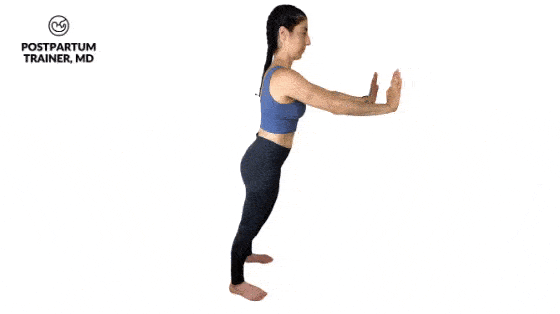
Wall Pulls
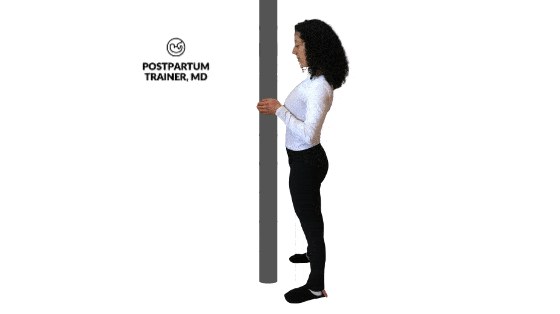
For more exercises to build arm strength check out: The Best Arm Toning Exercises Postpartum
To build muscle in your legs you can do:
Bodyweight Squats
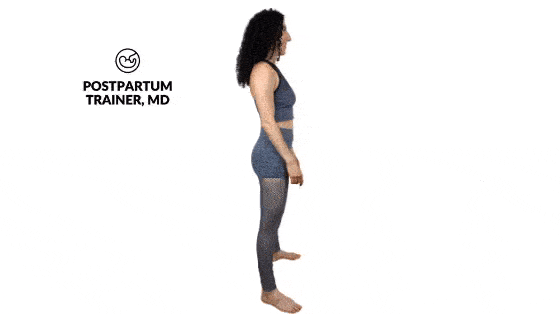
Box Squats
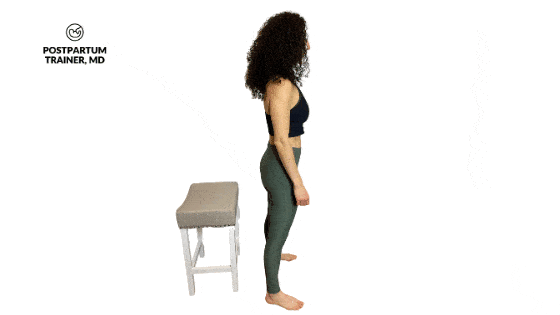
To learn more exercises to build muscle in your legs, check out 9 Easy Leg Exercises.
To build a stronger booty you can do:
Glute Bridges
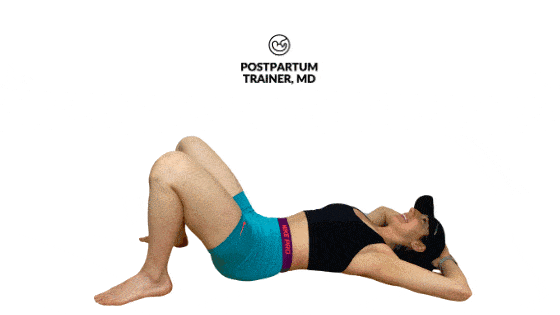
Side-Lying Clams
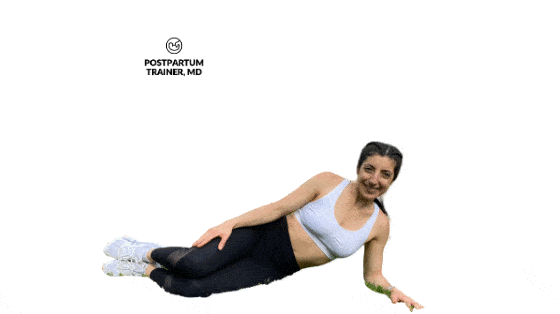
Check out How to Get Rid of Your Mom Bum to learn more exercises to grow your glutes.
To strengthen your core you should do:
Posterior pelvic tilts
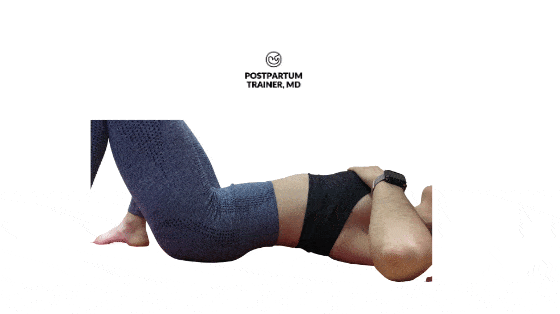
Modified Plank
*Use a tall incline when first starting out. The taller the incline the easier the exercise.*
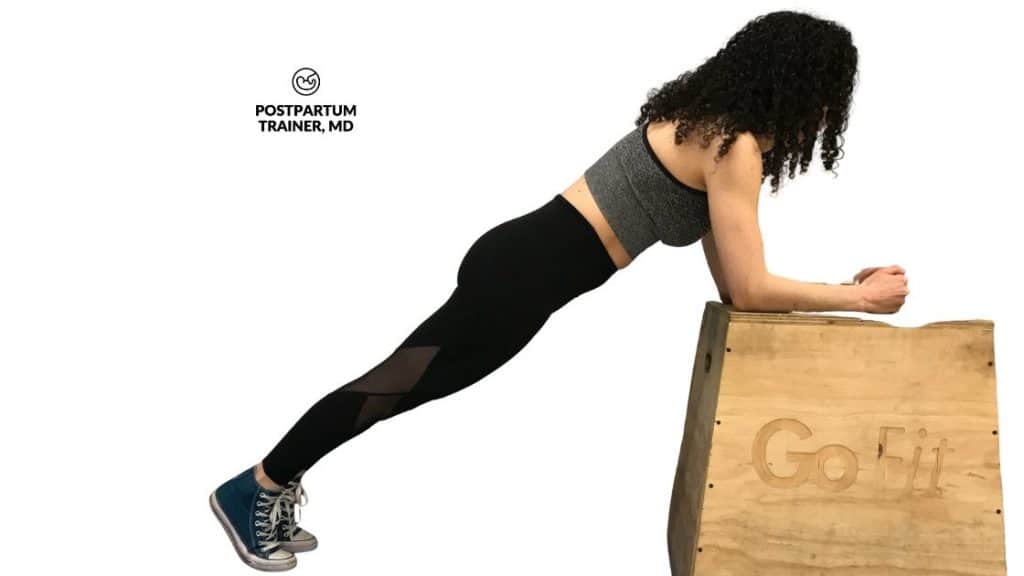
Diaphragmatic breathing
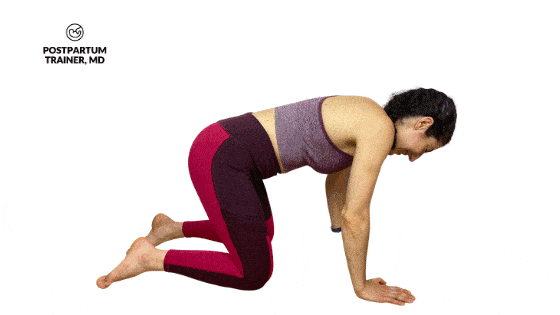
For more ab exercises, check out 100 Effective Exercises To Rebuild Your Core
To strengthen your pelvic floor your should do:
Kegels
This is the best exercise for strengthening the pelvic floor. You can do it while lying on your back or on your side. All you do is squeeze your pelvic floor muscles as if you were trying to not pee or poop!

Check out my other awesome Exercises to Strengthen Your Pelvic Floor.
How soon after birth can you exercise?
You should wait at least 4-6 weeks postpartum before engaging in any sort of moderate-high intensity exercise.
This is a general recommendation and it depends on a lot of factors such as:
- how active you were before you got pregnant,
- how active you were during your pregnancy,
- the type of delivery you had, and
- any postpartum complications you may have had.
Also, everyone is different.
You may be ready sooner than 4-6 weeks, or you may not feel ready at all by 6 weeks.
The most important thing is that you take it slow and listen to your body.
Once you are ready to start, here are a few guidelines you can follow to get started.
postpartum exercise guidelines
| 1. | Have a visit with your doctor to ensure you are cleared to workout |
| 2. | Make sure you are not experiencing any vaginal bleeding prior to working out |
| 3. | Avoid any exercises that cause pain or discomfort, even if slight |
| 4. | Always start slow and increase your workouts gradually |
| 5. | Keep your body hydrated |
Postpartum Exercise Plan
I am in the process of creating a postpartum exercise program that will take you from the first 6 weeks, all the way to the first 6 months.
If you are interested, sign up below to be notified of when it get’s released!
What About Diastasis Recti: Any Exercises To Avoid?
Diastasis Recti occurs when there is a midline separation in your rectus abdominis muscles.
This condition is actually quite common and can occur in 30-60% of postpartum women.
To find out if you have diastasis recti, check out “How To Tell If You Have Diastasis Recti” here.
Exercises to avoid with diastasis recti
If you have diastasis recti, you should avoid any exercise that places a high amount of tension on your abdominal muscles.
These include exercises like sit-ups, crunches, and full planks (similar to what was said above).
Doing these exercises too soon can worsen your condition.
If you are interested, I have created a complete list of 100 exercises you could perform to help fix your diastasi recti.
What about if I’m breastfeeding?
It is completely safe to do regular exercise while breastfeeding and I strongly recommend it.
As a breastfeeding mom, it is important to wear comfortable clothing while exercising. Especially a comfortable nursing sports bra like this one.
Otherwise, its important to stay hydrated throughout the day.
Also, try to make sure that you have pumped prior to your workout. I personally love using this hands free manual pump while breastfeeding my baby on the opposite breast or this portable hands free wireless pump when I want to multitask before my workout :).
If not, you may notice leakage from the nipples, which is where these awesome breast shells come in handy, and/or engorgement of the breasts which can be quite painful.
Avoid any exercise where you are lying flat on your stomach as this can be a cause of breast pain and discomfort.
Other Related Questions
Can you do squats postpartum?
Yes, you can squat postpartum, (without added weight), as long as your body is ready for it and you were cleared by your healthcare provider.
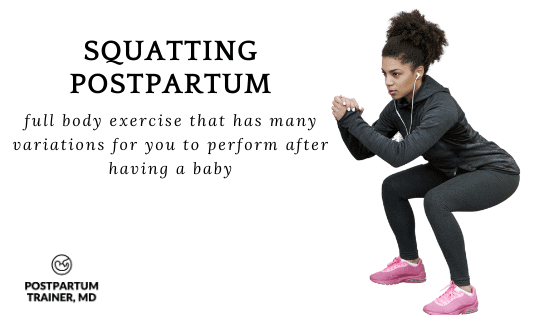
Squats are a fundamental exercise that we do every day, multiple times a day.
Just think about it, every time you go to the bathroom, sit down, and stand up, you are squatting.
As with all exercise the most important thing you could do is listen to your body.
If any squatting movement causes pain or discomfort, you should stop.
For your convenience I have an entire article on Squatting After Giving Birth.
Are planks good after pregnancy?
Full planks should be avoided after pregnancy as it places too much tension on your abdomen.
However, there are many variations of the plank that could be performed after pregnancy to strengthen your core including the:
Is walking good postpartum?
Walking is one of the best exercise you could perform postpartum.
In fact, I expect you to walk on the same day as your delivery, or on the next day if you had a cesarean section.
The benefits of walking are countless, however the most important one is preventing the formation of blood clots.
Your risk of developing blood clots is high during your pregnancy and postpartum period. In fact, they are a leading cause of morbidity and mortality in postpartum women.
When you leave the hospital, you should try to walk at least 15 minutes a day, 3-4 times a week.
For a detailed postpartum walking plan check out my Guide to Getting Fit After Pregnancy.
Final Words on Exercises to Avoid Postpartum
Exercising in the postpartum period is a great way to create a healthy lifestyle and one I strongly encourage.
Make sure you avoid any exercise that causes pain or discomfort and ones that require a lot of core strength.
Now I want to hear from you.
What is your favorite postpartum exercise?
Comment below and let me know!
Related Posts on Exercising in the Postpartum
- 17 Amazing Postnatal Stretches to do After Delivery
- Risks of Exercising Too Soon
- When Can You Lift Weights Postpartum
- How to Exercise Before Your 6 Week Visit
Get Four Free Workouts To Help Strengthen Your Pelvic Floor & Heal Your Mommy Tummy!

Brittany Robles, MD, MPH, CPT
Brittany Robles is a full-time OBGYN physician, a NASM certified trainer, and a prenatal and postnatal fitness specialist. She holds a Master of Public Health degree in maternal health with a special interest in exercise and nutrition. She is also the co-author of The White Coat Trainer. Learn more about her here.
Sharing is Caring – Send This To A Mom In Need!
